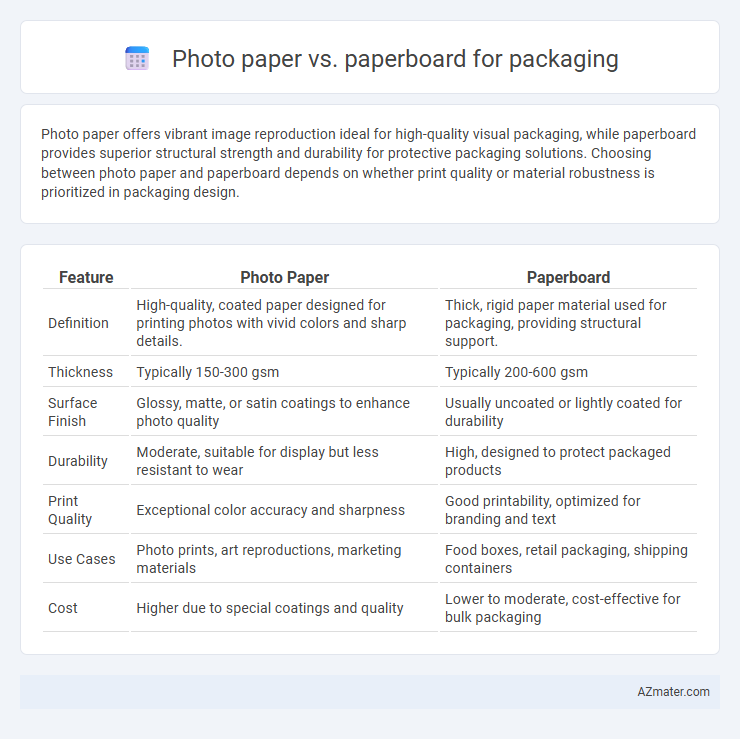Photo paper offers vibrant image reproduction ideal for high-quality visual packaging, while paperboard provides superior structural strength and durability for protective packaging solutions. Choosing between photo paper and paperboard depends on whether print quality or material robustness is prioritized in packaging design.
Table of Comparison
| Feature | Photo Paper | Paperboard |
|---|---|---|
| Definition | High-quality, coated paper designed for printing photos with vivid colors and sharp details. | Thick, rigid paper material used for packaging, providing structural support. |
| Thickness | Typically 150-300 gsm | Typically 200-600 gsm |
| Surface Finish | Glossy, matte, or satin coatings to enhance photo quality | Usually uncoated or lightly coated for durability |
| Durability | Moderate, suitable for display but less resistant to wear | High, designed to protect packaged products |
| Print Quality | Exceptional color accuracy and sharpness | Good printability, optimized for branding and text |
| Use Cases | Photo prints, art reproductions, marketing materials | Food boxes, retail packaging, shipping containers |
| Cost | Higher due to special coatings and quality | Lower to moderate, cost-effective for bulk packaging |
Introduction to Photo Paper and Paperboard
Photo paper is a specialized paper designed with a glossy or matte coating to produce high-quality images and vibrant colors in printing applications. Paperboard, a thicker and more durable material, serves as a primary packaging substrate, providing structural strength and protection for various products. Understanding the distinct characteristics of photo paper's smooth, image-friendly surface and paperboard's rigidity is essential for selecting the appropriate material in packaging solutions.
Material Composition and Structure
Photo paper is typically made of high-quality cellulose fibers coated with a layer of resin or clay to enhance brightness and image clarity, making it ideal for vibrant, detailed prints. Paperboard, composed of multiple layers of pulp fibers pressed and glued together, offers greater thickness and rigidity, providing superior strength and protection for packaging applications. The structural difference results in photo paper being smooth and thin for image reproduction, while paperboard delivers durability and sturdiness essential for packaging.
Printing Quality and Visual Appeal
Photo paper offers superior printing quality with high-resolution image reproduction and vibrant color accuracy, making it ideal for premium packaging that demands sharp visuals and detailed graphics. Paperboard provides a more rigid and durable structure but typically results in less vivid color output and lower print resolution compared to photo paper. For packaging that prioritizes visual appeal with intricate designs and photographic elements, photo paper enhances overall presentation, whereas paperboard balances aesthetics with strength and functionality.
Durability and Protection
Photo paper offers a smooth surface ideal for high-resolution printing but lacks the thickness and rigidity required for robust packaging protection. Paperboard, made from thicker, layered fibers, provides superior durability and impact resistance, making it preferable for safeguarding products during transit. Its structural strength prevents bending and punctures, ensuring enhanced protection compared to the delicate nature of photo paper.
Cost Comparison
Photo paper typically incurs higher costs due to its glossy finish and specialized coatings designed for high-quality image reproduction, making it less economical for large-scale packaging. Paperboard offers a cost-effective alternative with its thicker, more durable structure suitable for protective packaging, often sourced from recycled materials that reduce expenses. For businesses prioritizing budget over visual appeal, paperboard provides substantial savings while maintaining functional integrity in packaging applications.
Environmental Impact and Sustainability
Photo paper often contains plastic coatings and chemical treatments that hinder biodegradability and complicate recycling processes, leading to higher environmental impact. Paperboard, typically made from recycled fibers and being fully recyclable and biodegradable, offers a more sustainable packaging alternative with lower carbon footprint and less landfill waste. Choosing paperboard supports eco-friendly packaging strategies aligned with circular economy principles and reduced resource consumption.
Applications in Packaging Industries
Photo paper offers high-quality, glossy finishes ideal for premium product packaging that demands vibrant, detailed graphics to enhance brand appeal. Paperboard provides a sturdy, cost-effective solution frequently used for structural packaging such as boxes, cartons, and display units, ensuring durability and protection during shipping. Packaging industries leverage photo paper for luxury cosmetics and electronics packaging, while paperboard is favored for food, pharmaceutical, and retail packaging with a focus on sustainability and functionality.
Customization and Finishing Options
Photo paper offers vibrant, high-resolution printing ideal for detailed images and photo-quality packaging, with customization options including glossy, matte, and satin finishes to enhance visual appeal. Paperboard provides a sturdy base suitable for structural packaging, allowing various finishing techniques such as embossing, debossing, spot UV coating, and foil stamping to create tactile and premium effects. Both materials support tailored printing designs, but paperboard excels in durable, functional packaging with enhanced finishing versatility for branding impact.
Consumer Perception and Branding
Photo paper offers a glossy, high-resolution finish that enhances visual appeal and conveys premium quality, thereby strengthening brand perception in luxury and retail packaging. Paperboard provides durability and a matte or textured surface that communicates eco-friendliness and reliability, appealing to environmentally conscious consumers. Brands leveraging photo paper typically emphasize vibrant imagery and sophistication, while paperboard aligns with sustainability messaging and tactile engagement, influencing buyer trust and loyalty.
Choosing the Right Material for Your Packaging Needs
Photo paper offers high-quality print resolution and vibrant color reproduction, making it ideal for packaging that requires detailed imagery and premium presentation. Paperboard provides superior durability, rigidity, and protection, suited for packaging that demands structural strength and resistance to damage during shipping. Selecting the right material depends on your packaging priorities--opt for photo paper when aesthetic appeal is paramount, while paperboard is the better choice for robust and protective packaging solutions.

Infographic: Photo paper vs Paperboard for Packaging
 azmater.com
azmater.com